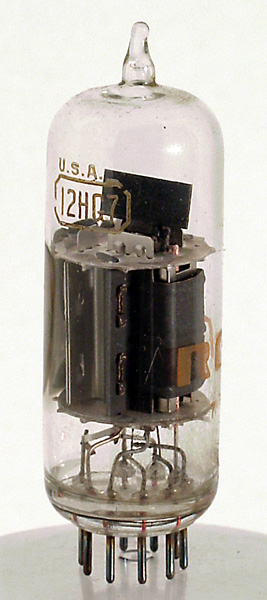
|
The RCA 12HG7 is quite an obscure type. The function that is was designed for is as the luminance output stage for colour television. B&O of Denmark imported them from America for use in their early colour sets as they (supposedly) give better performance than the otherwise standard PL802 in terms of voltage swing and bandwidth. Thanks to Tim Jarman for this detailed information.Henning Hertz adds that the 12HG7 was used in the Bang & Olufsen late 1960's Beovision 2600/3100 series for luminance (video) amplification.The 12HG7 has a 12.6 volt centre tapped heater. The maximum dissipations of the anode is 10 Watts with a maximum anode voltage of 400 Volts. It is s sharp cut-off pentode and is of frame grid construction. This tensioned grid wire technique and flat cathode construction allows for very close positioning of the grid with respect to the cathode and thus a high gm value can be produced. A high gm being an essential feature in an active device for a wide bandwidth amplifier.The thin glass tube envelope is 20 mm in diameter and, excluding the B9A base pins, is 58 mm tall.References: Data-sheet, Tim Jarman & Henning Hertz. Type 12HG7 was first introduced in 1965. See also 1965 adverts. |
Pin Connections
| 1 | 2 | 3 | 4 | 5 | 6 | 7 | 8 | 9 |  k | g1 | g3 | h | h | hct | a | g2 | g3 |
|
|
Absolute Maximum Operating Conditions¶
| Vh | Ah | Va | Vs | mAa | mAs | ra | gm | μ | 
| 6.3 | 0.52 | 300 | 135 | 31.0 | 4.8 | 60,000 | 32 | 1920 |
|
Updated January 29, 2013.
|
|